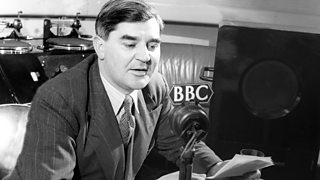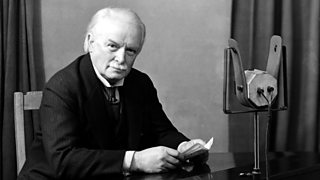Wales - and the Welsh people in general - played an important role in the creation of universal health care in the UK.
and were key figures in the creation of a ‘health for all’ culture but long before they came to prominence in the twentieth century, caring for less fortunate members of the community was an important part of Welsh society.

Rt. Hon. Aneurin Bevan, Minister of Health, speaking in 1942
During the Middle Ages people in Wales developed a tradition of collective loyalty within their communities, wherever or whatever those communities might be. Put simply, people in the village or town looked after their own! Family was at the heart of this collective care but it did not stop there. If someone was in need, help was usually at hand.
Of course, such help was usually quite primitive. Unless an injured man or woman was very lucky, something like a broken limb could well mean death; diseases such as the plague certainly did.
Treatment was limited to herbs and potions and while the reputation of healers and herbalists like the 12th century was undoubtedly well-deserved, by modern standards their remedies were basic in the extreme.
Despite this, general health care was surprisingly good in the isolated Welsh communities. The writer , on his tour through Wales in the 1180s, spoke very highly of the health of the people.
Despite being of aristocratic Norman origin and naturally disdainful of the lifestyles of ordinary working people, Giraldus was clear that the Welsh were very stringent about cleanliness, comparing their practices most favourably to other nationalities in Europe. He particularly noted the way the Welsh cleaned their teeth using small hazel twigs.
Much of the help given to sick people was, for many years, in the hands of the local ‘wise woman’ or the elderly members of the family. Monasteries and other religious settlements could and often did offer beds and treatment to the sick with monks, friars and nuns putting their own safety to one side in an attempt to aid those in need.
Such help, naturally enough, depended as much on geographic location as anything else – put simply, it depended on whether or not there was a monastery in your area. The in the years after 1536 effectively put an end to such assistance.
The 18th and early 19th centuries saw a dramatic change from a rural environment to an industrial one as Wales, fuelled by copper, slate, iron and coal, became one of the industrial powerhouses of the world. Inevitably, in the new world that was being created health care was now linked to, and governed by, such things as the social and economic conditions that people were forced to endure.
By the end of the 19th century the population of Wales had risen from the fairly consistent 350,000 of the mid-17th century to an amazing two million. People came in their thousands to the industrial areas of Glamorgan and Monmouthshire, lured by the iron works and coal mines. And, of course, industry brought with it distinct problems in the area of public health.
Among other things, poor housing, overcrowding and lack of proper sanitation quickly proved to be a fertile breeding ground for diseases such as cholera and typhus. In the cholera outbreak of 1848 no fewer than 3,000 people died in Glamorgan alone. In Cardiff the death toll was just over 300 but overcrowded and unhealthy Merthyr Tydfil lost 1,389.
One of the results of this tragedy was the setting up of Boards of Health. By 1872 over one million pounds had been invested, by the government, in sewerage and water supply. Some of this, although clearly not all, was spent on the industrial areas of Wales.
The was intended to further combat the squalid living conditions of people in urban environments but, unfortunately, its effects were delayed as the mine owners and iron masters were supposed to help pay for the improvements – something they bitterly resented and fought against.
In lieu of other help, many people in the mining communities and in port cities like Cardiff paid into insurance schemes or Friendly Societies – perhaps a penny a week – that would give them a fund to ‘tap into’ if they required medical treatment. That was fine, but it did not even begin to help those operating just above the poverty line or who were actually out of work.
Hospitals were usually provided by charities or, in cases like the or the in Cardiff Docks, through the levying of a toll collected out of men’s wages. There were a number of small isolation hospitals across Wales, set up in the 19th century and catering for people with diseases like smallpox, scarlet fever and diphtheria – again, usually paid for by contributions from working men.

Rt. Hon. David Lloyd George in 1931
Lloyd George’s National Insurance Scheme of 1911 did provide some sort of help but worked on the basis of contributions from individuals, employers and the state. The only treatment it catered for directly was for people suffering from TB – Wales was one of the worst affected parts of Britain – and, crucially, it did not cover dependents.
When the Depression hit Wales in the 1920s there were immediate cuts in wages and many mines closed. In Merthyr Tydfil alone the unemployment figure rose to nearly 70%. The result was an immediate blow to the health of out of work miners and their families. By the time of the in 1944 it was clear that something had to be done and Aneurin Bevan, Minister for Health in the post-war Labour Government – himself a miner before being elected to Parliament - forced through legislation to provide health care that was based on citizenship rather than employment, class or money.
Despite their fine and ancient traditions of health care, the people of Wales had suffered grievously in the aftermath of industrialisation. With the creation of the National Health Service an intolerable burden had been lifted from the shoulders of the working men and their families.
������̳ Wales is looking at the health of our NHS in 'Health Check Wales' for a week from Sunday 25 January 2015 on TV, radio and online.
